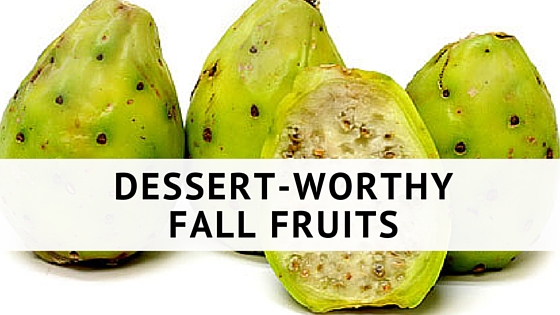When you think about delicious Fall food foods, if you’re like most people your mind probably wanders to Fall veggies like butternut squash, brussels sprouts, and sweet potatoes. But keep in mind, with Fall vegetables comes Fall fruits, and they can make the perfect end to a perfect meal. So the next time you’re at the grocery store or the farmers market, hunt down these Fall fruits to enjoy long into the cool weather.
What to Get: Date Plum
The date plum is similar to the persimmon and is usually grown in the Mediterranean, Turkey, and India. Even though the date plum is small in size, it packs a pretty big punch. The interior is velvety and sugar, and while you can easily whip them up into a fancy dessert, they’re also just as good completely plain.
How to Eat It: One the best ways to prepare the date plum is to mash some of them and mix with water to create a paste. Spread it out on parchment paper and bake at 200 degrees for 3 hours or until the fruit is “tacky”.
What to Get: Guava
If you’ve ever spent time in a tropical location, especially if it was in south or central America or the Caribbean, you’ve probably tried guava. It’s got an outer skin that’s thick and similar to the skin of a lemon. Inside, though, it’s sweet and has the consistency and texture of an apple. Just make sure you wait until they’re ripe – otherwise they can be pretty tough.
How to Eat It: It’s common to eat guava fruit raw. To eat it like a local, sprinkle it with some sugar and a little salt, and enjoy. Or, if you’re feeling more adventurous, try making a dipping sauce from soy sauce or vinegar, which is popular in some parts of Asia.
What to Get: Cactus Pear
Thought to be native to Mexico and grow in dry, arid parts of the world, the cactus pear is a striking looking fruit that has a neon colored exterior and produces a sweet delicious juice that has a flavor that’s often explained as being a mix of watermelon and bubblegum. Seriously.
How to Eat It: Getting to the delicious interior or a cactus pear isn’t always the easiest thing. Because it’s prickly, you’ll first need to remove the glochids or prickly parts of the pear. You can do this with a blow torch, as a little bit of fire will burn these suckers right off without cooking or burning the fruit. Added bonus? You get to play with fire.
Next, chop the cactus pear in half and scoop out the interior fruit. Blend this with a little water and some additional fruit to create a smoothie. Remember to run the water and cactus pear juice through a sieve to get rid of the seeds first.
What to Get: Quince
Fun fact: quince is the only member of the genus Cydonia, which is also a part of the family of apples and pears. Quince actually looks a lot like an apple, although a bit lumpier and with rougher skin. On its own, it’s not a very sweet fruit. But if you have a few minutes and are up to the task, quince can be cooked to create delicious fruit and desserts.
How to Eat It: The best way to cook quince is to poach it. Start by peeling and cutting quince into slices. Add to a large pot, 4 cups of water, 1/2 cup of sugar, and 1/4 cup of honey. Add the quince slices and bring to a boil. Once it’s boiling, cover partially and simmer for 45-50 minutes or until quince is slightly pink and the flesh is tender. Drain and serve quince by itself or use it as an ingredient in other dishes – from sweet to savory. But one thing you shouldn’t do is pour out the juice you poached it in. It makes a delicious sauce and syrup that can be used with almost anything, so make sure to bottle it up and refrigerate it until further use.





